 |
Fort Adams
Newport, Rhode Island, USA
|
|
 |
Constructed: 1824 - 1857
Designed by: Simon Bernard
Built by: Joseph Totten
Used by: United States of America
Conflicts in which it participated:
Used as a training facility and garrisoned until 1950, but never attacked
|
The city of Newport sits at Narragansett Bay, which is one of several natural deepwater harbors that is frequently described as the best in the world. It certainly is a fine harbor, and thus everybody with a ship, from Spaniards to Frenchmen to pirates to...Noah, assumedly, wanted it for themselves.
|
 |
|
|
Western man first stumbled into the bay in the early 16th century, when the Narragansett Indians were living on the west side of the bay, the Wampanoags on the east. Italian explorer Giovanni da Verranzzano (1485-1528) sailed into the bay in 1524, and named it Refugio. Dutch explorers came nosing around shortly thereafter, but the first European settlement waited until 1636: Dissatisfied Plymouth colonist Roger Williams (1603-1683) led a group of settlers into the area. The city of Newport was founded in 1639. In 1643, England's King Charles I (1600-1649) granted Williams a charter for the new colony of Rhode Island.
|
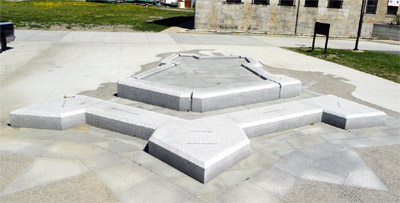 A very cool model of Fort Adams that sits outside the fort's front gate A very cool model of Fort Adams that sits outside the fort's front gate |
 |
Fortifications are expensive things, and though it was pretty obvious to everyone in Newport that they'd need to fend off attackers sooner or later, collecting the necessary cash for such an endeavor as defense proved difficult. A weird variety of earthworks and small masonry fortifications were built around the bay starting in 1702, but the short range of contemporary cannon, coupled with an incomplete understanding of just which of the bay's entrance channels were deep enough to sail big ole ships through, made it possible for the |
|
British to bring a huge fleet into the bay on December 7, 1776...despite the earnest colonial American wish that they would not do that very thing. The British brought six thousand troops into Newport unopposed and spent the next year effectively fortifying the city, so much so that a combined French and American fleet that descended upon Narragansett Bay in August of 1778 was unable to take Newport back.
The British left Newport in October of 1779, and the French moved in the following summer. Was this better, exchanging one European power for another? Maybe, but if nothing else the French worked their fortification magic at and around the bay while in residence, and the French were widely considered to be the definitive fortifiers at the time...although it seems as though the British did a pretty darned good job of it too.
|
After the Treaty of Paris ended the American Revolutionary War in 1783, Newport followed the standard American practice of exerting not one iota of thought on defense in peacetime, and the impressive array of defenses around the bay rotted.
In January of 1793, France beheaded King Louis XVI (1754-1793), which most of the other European monarchs found both improper and worrisome. As Europe geared up for war once again, the merchants of Newport found they had regained their interest in fortification.
|
 |
One of many unrestored rooms (in fact the place is just about all unrestored rooms) along the fort's southwest wall |
|
Louis de Tousard (1749-1817) was a French artillery officer who had served with the Continental Army during the American Revolution. He had lost an arm fighting to reclaim Newport from the British in 1778, and when he returned to America in 1795 to look for it, was given a commission as a Major in the US army. Tousard directed construction of several works around Narragansett Bay, and completed work on the first iteration of the starfort of our current interest, Fort Adams.
A ceremony was held on July 4, 1799 to officially declare that Fort Adams was open for business and ready to defend American shores. The fort was named for US President John Adams (1735-1826), and a stone tablet with the inscription, Fort Adams - The Rock on Which the Storm Will Beat was placed over the fort's main gate. This first Fort Adams only mounted seventeen guns, and though it was eagerly garrisoned by Rhode Island militia during the War of 1812 (1812-1814), the British contented themselves with blockading Narragansett Bay without entering it, so terrified were they of the dreaded Fort Adams. Well. Actually the Royal Navy had insufficient information as to the bay's relatively weak defense, so took the prudent course and stayed out. |
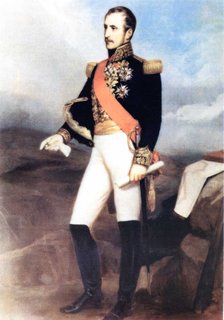 Simon Bernard of the Simon Bernard of the
Fancy Napoleonic Pants Brigade |
 |
One of President James Monroe (1758-1831)'s first priorities upon taking office was the seacoast defense of the US. A board was commissioned to study the issue and suggest likely locations for fortification, but the president had little faith in the experience of the army's engineers. Monroe appealed to France for assistance, and Simon Bernard (1779-1839), engineer and former aide-de-camp to Napoleon (1769-1821) himself, was immediately dispatched...or more accurately kicked out of France, as France's monarchy had reasserted itself and was less than forgiving of those who had been loyal to Napoleon. Republican or monarchist or whatever, Bernard sure could design forts. Fort Adams as it looks today, plus Fort Monroe in Virginia, and Fort Morgan in Alabama are examples of the engineerin' mind of Simon Bernard. By my count, Bernard was responsible for at least ten monstrously important third system American starforts. Was Bernard America's Vauban? Perhaps. |
|
Louis Tousard's earlier, lame version of Fort Adams was declared "worse than useless" and leveled. Construction of the gloriously starrish Fort Adams as it stands today began in 1824 under the watchful eye of Lieutenant Colonel Joseph Totten (1788-1864), who worked closely with Bernard and became the US' leading expert on fortification when the Frenchman was permitted to return to France in 1831. Totten would go on to become the army's Chief of Engineers, and have a small starfort of his very own named after him, one of those of the Defenses of Washington DC during the US Civil War (1861-1865). I've been to Fort Totten outside DC, and based on how it looks today, the man for whom it was named would not have been impressed.
One of the most striking aspects of Fort Adams as viewed in the satellite image at the top of this page is the glacis, which is the browner, prickly-looking business that's slightly separated from the fort to the left: This is unique to American forts, and is an innovation of Joseph Totten's. This was built to defend the fort's southern, landward approach, and is honeycombed with a dizzying maze of tunnels, loopholes and (theoretically) slaughter-delivering batteries.
An advantage of those building forts during this period in the southern United States was the labor situation: Slaves! No problems with payment or the necessity of providing decent working conditions, just the issue of the subjugation of man, which didn't seem to bother anyone building Forts Monroe and Morgan at the time. In Rhode Island, this convenient form of labor wasn't available, so Totten frequently advertised in the local newspapers for masons and bricklayers. |
 |
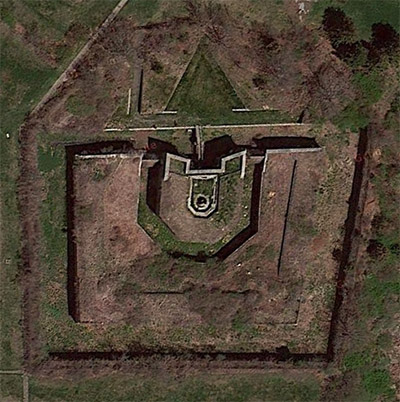
The Redoubt, to Fort Adam's south. Anyone attacking from the landward side would have had to get past this unlikely-looking structure first. |
The immigrant Irish population proved to be an extremely useful resource for Newport's starfort-building needs: Three generations of Irish folks worked on the project, were well compensated and, when Fort Adams was finally completed in 1857, Joseph Totten, by then Chief Engineer of the US Army, returned to Newport and offered all of those who had worked so hard to construct Fort Adams full US citizenship. Every one of them accepted. |
Fort Adams was designed to mount 486 guns, but as always seemed to be the case, once an expensive American fort was built, fully arming it was more costly than state or federal government would willingly act upon. Huge advances had also been made in the field of artillery over the 30+ years that it took to build Fort Adams, which further confused the issue.
|
 |
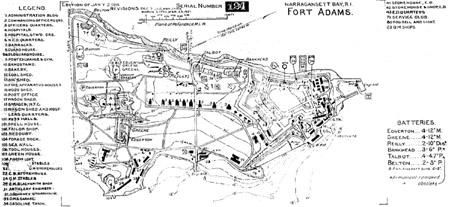 Thanks to FortWiki.com for these top-secret 1921 plans of Fort Adams! Thanks to FortWiki.com for these top-secret 1921 plans of Fort Adams! |
|
At the start of the US Civil War, Fort Adams mounted but a fraction of its intended armament: Smoothbore cannon in some of the three levels of casemates to deal with enemy ships, and short-range carronades en barbette on the fort's bastions, to fire canister or grapeshot against any parties directly approaching its walls. Although nobody expected the Confederate Navy to make it all the way to Narragansett Bay, Fort Adams was rearmed with state-of-the-art 10- and 15-inch Rodman Guns anyway, because who knows what ridiculousness those pesky European powers might get up to while we're distracted? Fears regarding the Confederate sympathies of Maryland prompted the US Navy to move its Naval Academy from Annapolis to Newport in 1861: For a brief period Fort Adams was the official site of the Academy. For an equally brief period, Brigadier General Robert Anderson (1805-1871) served as Fort Adams' commanding officer: Anderson was the much-loved former commander of Fort Sumter at Charleston, South Carolina, whose bombardment and eventual capture by the fledgling Confederacy had been the first act of the US Civil War in April of 1861. His nerves shot from the experience yet still regarded as a hero, Anderson was shuffled around from peaceful place to non-active place in an attempt to allow him to relax and recover. He served for two months at Fort Adams in 1863, before doddering off to someplace even less stressful. The Endicott Board of the 1880's designated 27 strategic locations of vast importance to the nation's coastal defense, and started pouring money into them accordingly in the 1890's. Narragansett Bay was ranked number 11, which meant that a modern upgrade of the bay's defenses had barely gotten underway at the start of the Spanish-American War (1898). Had the nonexistent-but-still-scary Spanish Fleet steamed into the bay in 1898, it would have been confronted with Fort Adams' same Rodman Guns that had seemed so cool during the Civil War. Plus a few modern weapons scattered about, but certainly not enough to prevent a modern, determined adversary.
|
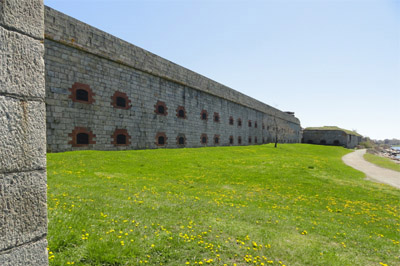 Fort Adams' west wall Fort Adams' west wall |
 |
When the Endicott-era upgrade was finally completed at Fort Adams in 1907, the fort fortunately had escaped the fate of many other American starforts in that it was not subjected to thousands of tons of concrete besmirching its lovely visage: All of the modern gun batteries were built outside the fort's walls. A small control room for the operation of electrically-fired mines was built atop the fort's western curtain wall, but...honestly, just look at Fort Delaware to see what a huge, ugly, Endicottian bullet Fort Adams dodged. |
|
Fort Adams was used as a training facility during the First World War (1914-1918), with special emphasis placed on urban conflict. American troops went to Europe with no expectation of, or training for, street fighting, and were offended to find that Germans did wish to fight in such an undignified manner. Mock city streets were set up at Fort Adams, wherein, one imagines, dudes dressed up like the Kaiser leapt out, shrieking, at unsuspectingly terrified doughboys.
The Second World War (1939-1945) saw Fort Adams again utilized as a training facility. Enormous 16-inch guns, with a range of 26 miles, were placed at Forts Greene and Church, from whence they covered all of Narragansett Bay from U-Boat attack. The army's peak strength at the Fort Adams complex was 3000 in 1940, manning everything from minefields to anti-aircraft guns.
During the lengthy periods betwixt America's wars, Fort Adams was often left abandoned, sometimes not even locked up. Often, the fort's infrastructure, such as its plumbing, windows, doors and even floors, were taken by Newport's residents: Need some plumbing? Just head on up to the fort and get what you want!
Fort Adams had initially been built with the same housing for its officers as enlisted men, which was essentially just a series of damp, cold casemates. When the fort was designed in the 1820's, the dizzying concept of equality for all blew strong in the Wind of Liberty. General or private, all will be equal under the stars 'n' stripes! As time went on and senior officers cycled through Fort Adams, however, they found that this equality business might work for privates and corporals and sergeants, but...come on. Officers eventually complained loudly enough to cause the construction of several plush homes on the fort's extended grounds for their benefit.
|
Fort Adams was closed as a coastal defense facility in June of 1950. In 1953 the Army gave the fort to the Navy, which used the fort for storage, but mostly allowed it to rot. Fortunately, US President Dwight D. Eisenhower (1890-1969) spent two presidential summer vacations at Fort Adams' commanding officer's quarters, and played a key role in keeping the fort in the shape of a fort: In the early 1960's, when the former president caught wind that the Navy was considering scrapping Fort Adams altogether, he said, "Not my Fort Adams!" In 1965 the Navy handed Fort Adams over to the state of Rhode Island, which opened it shortly thereafter as a State Park.
Today, the fort has been partially restored, but is fully gorgeous, inside and out. The Newport Jazz Festival has been held annually at the fort since 1981. One can only get into the fort as part of a guided tour, which are currently held twice a day from mid-May until Labor Day in September.
|
 |
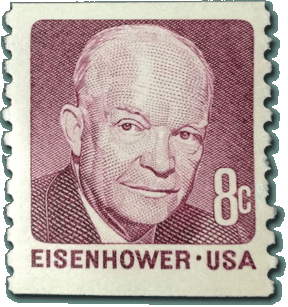 Thank you, Dwight D. Eisenhower, for singlehandedly saving Fort Adams. Thank you, Dwight D. Eisenhower, for singlehandedly saving Fort Adams. |
|
Fort Adams holds an event known as Tunnels of Terror and/or Fortress of Nightmares (might I suggest Starfort of Acute Unease?) around Halloween, which looks to involve attendees being thrust into the awesome tunnels under the glacis, where they are chased about in a merry fashion by zombies and/or mummies and/or vampires and/or such. I visited Fort Adams in early May of 2013, and managed to get briefly separated from my tour group and lost in those tunnels! Nobody dressed as the Kaiser was leaping out at me, however, so it was more exhilarating than scary. Won't you visit my report on Fort Adams in the Starforts I've Visited section?
|
|
|
|
|
|
 |




